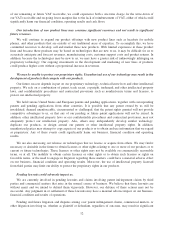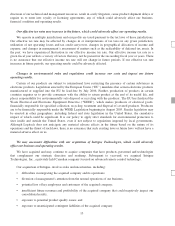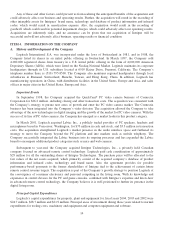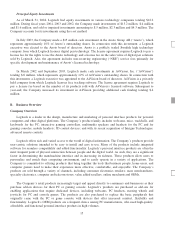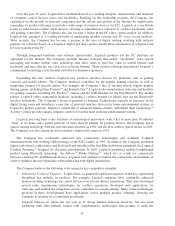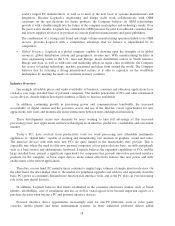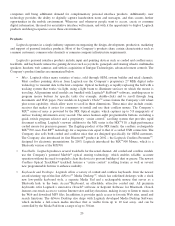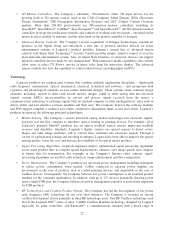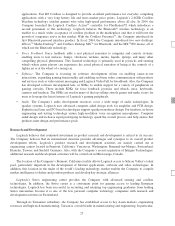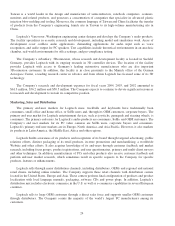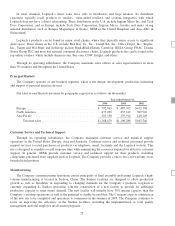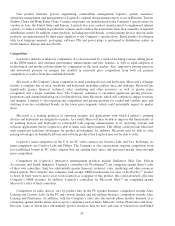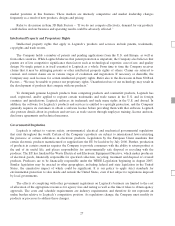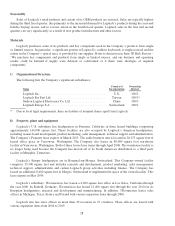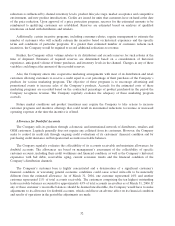Logitech 2004 Annual Report Download - page 60
Download and view the complete annual report
Please find page 60 of the 2004 Logitech annual report below. You can navigate through the pages in the report by either clicking on the pages listed below, or by using the keyword search tool below to find specific information within the annual report.•3D Motion Controllers. The Company’s subsidiary, 3Dconnexion, offers 3D input devices for the
growing field of 3D motion control, used in the CAD (Computer Aided Design), EDA (Electronic
Design Automation), GIS (Geographic Information Systems) and DCC (Digital Content Creation)
markets. More than 200,000 professionals use 3Dconnexion motion controllers, including its
SpaceBall®, SpaceMouse®,CadMan
®, SpaceNavigator™and SpaceTraveler™. All 3Dconnexion motion
controllers leverage the productivity benefits and comfort of working with two hands – one hand on the
mouse to select, modify or annotate, and the other hand on the motion controller to navigate.
•Advanced Remote Controls. The Company’s recent acquisition of Intrigue Technologies expands its
presence in the digital living and introduces a new line of personal interface devices for home
entertainment systems to Logitech’s product portfolio. Intrigue’s current line of advanced remote
controls with Smart State Technology™Activity Control provides simple, intuitive control of even the
most elaborate entertainment system. Also, its Smart State Database of electronic devices can support
infrared-controlled devices made by any manufacturer. With interactive media capabilities, the controls
allow users to select TV Shows, movies or music titles from the interactive display. The advanced
remote controls also have the capability to control other devices, including lights and PCs.
Technology
Logitech products are sophisticated systems that combine multiple engineering disciplines – lightweight
radio frequency transmission, optical, mechanical, electrical, acoustical and software – and incorporate both
cognitive and physiological elements in user-centric industrial designs. These systems share common design
elements, including: sensors to detect and encode motion, images, sound or other analog data into electrical
signals; custom ASICs; microcontrollers to convert and process signals received from the sensor; a
communications subsystem to exchange signals with an attached computer or other intelligent host; and a suite of
driver, utility and user interface software modules and Web sites. The Company believes the software modules
and Web support complete a seamless user-centric solution for information input, access and control. Logitech’s
products incorporate the following principal technologies:
•Motion Sensing. The Company’s sensors transform analog motion and images into electronic signals.
Logitech was the first company to introduce optical sensing in pointing devices. For example, all of
Logitech’s patented Marble®products use an optical trackball sensor, greatly improving trackball
accuracy and durability. Similarly, Logitech’s digital cameras use optical sensors to detect colors,
shapes and other image attributes, and to convert these attributes into electronic signals. Through a
variety of sophisticated sensing and encoding techniques, Logitech has been able to improve the optical
sensing quality, lower the cost, and increase the reliability of its optical mouse products.
•Signal Processing Algorithms. Logitech engineers employ sophisticated signal processing algorithms
across many product lines to compute spatial displacements, enhance color image quality and compress
or format data for transmission. For example, in the Company’s Internet video cameras, signal-
processing algorithms are used for color extraction, image enhancement and data compression.
•Power Management. The Company’s products use advanced power management including techniques
to reduce power consumption when needed. Cables connected to separate power supplies are
inconvenient in the case of products such as corded pointing devices, and impossible in the case of
cordless devices. Consequently, the Company believes low power consumption is an essential product
attribute for the consumer marketplace. In addition, with up to 127 devices potentially drawing power
from a single USB port, the Company believes its power management expertise is particularly important
for USB products.
•RF Technologies and Cordless Product Design. The Company has led the development of low power
radio frequency (RF) technology for use over short distances. The Company is focusing its current
cordless development efforts primarily in three RF technology areas: Fast RF Cordless technology used
first in the Logitech MX™series of mice; 2.4GHz Cordless Freedom technology designed by Logitech
especially for game controllers; and Bluetooth®, a communications standard with a broad range of
22


